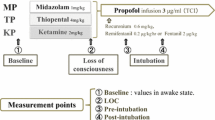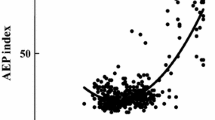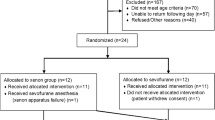Abstract
Purpose
It is still controversial whether an electroencephalogram could be a useful monitor of sedation levels. The present study was performed to compare the bispectral index (BIS) and the auditory evoked potentials index (AAI) during light sedation with propofol infusion in spinal anesthesia.
Methods
Eighty patients, aged 20 to 70 years, scheduled for surgery of the lower extremities under spinal anesthesia were assigned to one of four groups (20 patients each). Patients in the AAI propofol and BIS propofol groups were sedated with propofol infusion at an initial rate of 2 mg·kg−1·h−1. Propofol infusion was controlled to try to keep the observer’s assessment of alertness/sedation (OAAS) scale at 3 or 4. Patients in the AAI control and BIS control groups did not receive propofol.
Results
The OAAS scales and the AAI or BIS decreased significantly in all groups during surgery, while the decrease was larger in the AAI propofol and BIS propofol groups. The AAI was significantly lower along with lower OAAS scales. There was no overlap in the AAI between OAAS scale 3 and scale 5 in the AAI propofol group, while in the BIS propofol group, no difference was observed in the BIS among OAAS scales 2, 3, 4, and 5.
Conclusion
The AAI, but not the BIS, could discriminate slight changes of consciousness during light sedation with propofol infusion in patients with spinal anesthesia.
Similar content being viewed by others
References
Glass PS, Bloom M, Kearse L, Rosow C, Sebel P, Manberg P. Bispectral analysis measures sedation and memory effects of propofol, midazolam, isoflurane, and alfentanil in healthy volunteers. Anesthesiology. 1997;86:836–847.
Ibrahim AE, Taraday JK, Kharasch ED. Bispectral index monitoring during sedation with sevoflurane, midazolam, and propofol. Anesthesiology. 2001;95:1151–1159.
Nishiyama T. Changes in the auditory evoked potentials index by induction doses of four different intravenous anesthetics. Acta Anaesthesiol Scand. 2005;49:1326–1329.
Barr G, Anderson RE, Jakobsson JG. A study of bispectral analysis and auditory evoked potential indices during propofol-induced hypnosis in volunteers. Anaesthesia. 2001;56:879–905.
Ozkan-Seyhan T, Sungur MO, Senturk E, Karadeniz M, Basel A, Senturk M, Akpir K. BIS guided sedation with propofol during spinal anaesthesia: influence of anaesthetic level on sedation requirement. Br J Anaesth. 2006;96:645–649.
Nishiyama T. Effects of the click sounds of the auditory evoked potentials on Bispectral index and entropy. Anesth Analg. 2008;107:545–548.
Gentili M, Chau Huu P, Enel D, Hollande J, Bonnet F. Sedation depends on the level of sensory block induced by spinal anaesthesia. Br J Anaesth. 1998;81:970–971.
Pollock JE, Neal JM, Liu SS, Burkhead D, Polissar N. Sedation during spinal anesthesia. Anesthesiology. 2000;93:728–734.
Brunner MD, Nel MR, Fernandes R, Thornton C, Newton DEF. Auditory evoked response during propofol anaesthesia after preinduction with midazolam. Br J Anaesth. 2002;89:325–327.
Nishiyama T. Propofol infusion for sedation during spinal anesthesia. J Anesth. 2007;21:265–269.
Pickworth WB, Herning RI, Koeppl B, Henningfield JE. Dosedependent atropine-induced changes in spontaneous electroencephalogram in human volunteers. Mil Med. 1990;155:166–170.
Thornton C, Sharpe RM. Evoked responses in anaesthesia. Br J Anaesth. 1998;81:771–781.
Duek MH, Petzke F, Gerbershagen HJ, Paul M, Heßelmann V, Girnus R, Krug B, Sorger B, Goebel R, Lehrke R, Sturm V, Boerner U. Propofol attenuates responses of the auditory cortex to acoustic stimulation in a dose-dependent manner: a FMRI study. Acta Anaesthesiol Scand. 2005;49:784–791.
Thornton C. Evoked potentials in anaesthesia. Eur J Anaesthesiol. 1991;8:89–107.
Jensen EW, Lindholm P, Henneberg SW. Autoregressive modeling with exogenous input of middle-latency auditory-evoked potentials to measure rapid changes in depth of anesthesia. Methods Inf Med. 1996;35:256–260.
Nasraway SA, Wu EC, Kelleher RM, Yasuda CM, Donnelly AM. How reliable is the bispectral index in critically ill patients? A prospective, comparative, single-blinded observer study. Crit Care Med. 2002;30:1483–1487.
Gajraj RJ, Doi M, Mantzaridis H, Kenny GNC. Analysis of the EEG bispectrum, auditory evoked potentials and the EEG power spectrum during repeated transitions from consciousness to unconsciousness. Br J Anaesth. 1998;80:46–52.
Iselin-Chaves IA, Flaishon R, Sebel PS, Howall S, Gan TJ, Sigl J, Ginsberg B, Glass PA. The effect of the interaction of propofol and alfentanil on recall, loss of consciousness, and the bispectral index. Anesth Analg. 1998;87:949–955.
Hadzidiakos D, Petersen S, Baars J, Herold K, Rehberg B. Comparison of a new composite index based on midlatency auditory evoked potentials and electroencephalographic parameters with bispectral index (BIS) during moderate propofol sedation. Eur J Anaesthesiol. 2006;23:931–936.
Author information
Authors and Affiliations
Additional information
This work was done at the Department of Anesthesiology, Ofuna Chuo Hospital, Kanagawa, Japan.
About this article
Cite this article
Nishiyama, T. Auditory evoked potentials index versus bispectral index during propofol sedation in spinal anesthesia. J Anesth 23, 26–30 (2009). https://doi.org/10.1007/s00540-008-0678-3
Received:
Accepted:
Published:
Issue Date:
DOI: https://doi.org/10.1007/s00540-008-0678-3




